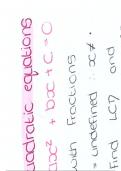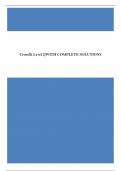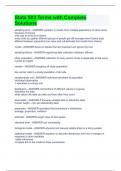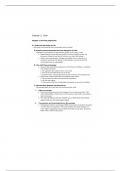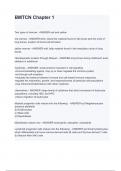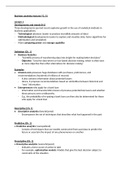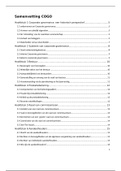Managing and Improving Quality
WEEK 1
A successful business delivers value:
- for customers: beneficial product or survice
- for employees: respect, training and meaningful work
- for investors: high returns
- for society: no environmental impact or social harm
“A complaint is a gift, most customers just do not return.”
Quality History
- Age of Craftsmanship: direct contact with customers, informal approach to quality
- Industrial revolution: larger volumes, no direct contact with customer
- Taylor: Principles of Scientific Management: planning and execution separated, job
segmentation, focus on efficiency
- Henry Ford: total quality practices
- After WO2: organizational approach to quality
- Japanese products have higher quality levels
What is Quality:
- Excellence
- judgement is different for everyone, abstract, can’t be defined or measured
- Value
- combination of what you get from a product relative to what you paid for it,
subjective; depends on consumer preference for value
- Conformance to specifications
- objective, but can more easily be measured
- Meeting customer expectations
- quality lies in the eye of the beholder, objective
- Product-based
- the presence of attributes in a product or service
Eight Dimensions of Product Quality (Garvin)
• Performance: primary operating characteristics of a product
• Features: secondary characteristics
• Reliability: the probability of a product’s failing
• Conformance: degree to which product’s design and operating characteristics match
pre-established standards
• Durability: the lifetime of the product
• Serviceability: the ease of maintenance and repair
• Aesthetics: how a product looks, feels, smells, sounds, and tastes
• Perceived quality: reputation of product in marketplace
, - Service Quality gap: gap between expected and perceived service
- Knowledge gap: management perceptions of customer expectations vs word-of-mouth
communications
- Communications gap: gap between service delivery and external communications
- Delivery gap: gap between service delivery and translations of perceptions into service
quality specifications
- Standards gap: gap between management perceptions of consumer expectations and
translations of perceptions into service quality specifications
Ten Quality Dimensions in Service (SERVQUAL)
- Reliability: ability to perform promised service accurately
- Responsiveness: willingness to help customers
- Competence/Skill: personnel has the necessary knowledge and skills
- Accessibility: simple and effective access to the organization
- Courtesy/Friendliness: treat customers politely and with respect
- Communication: keep customers informed, listening, clear language
- Credibility: confidence and honesty as radiated by the organization and its personnel
- Safety/Security: free of danger, risk or doubt
- Understanding the Customer: investigate customer needs
- Tangibles: Items that are part of the service
Refinement of ten dimensions:
,Product Quality in Design
- Primary customer values:
- Performability
- Affordability
- Feutureability - will it provide added benefits?
- Deliverability - will it be ready when I want it?
- Usability
- Maintainability
- Durability
- Imageability - Will it convey an image of quality and prestige?
- Primary Company Values
- Profitability
- Investability
- Riskability
- Produceability
- Marketability
- Growability - Does it offer market expansion?
- Leverageability
- Respectability - Will it strengthen our reputation?
Seven worst design solutions:
- Complex
- Precise
- Variable
- Sensitive
- Immature
- Dangerous
- Skill intensive
Conclusion of what is quality:
- focus on the customer
- balance between costs and benefits
Total Quality Management:
- Juran:
- Voice of Customer: spoken and unspoken needs of customer
- Internal customer: each person in the supply chain is a supplier but also a
customer
- Costs of quality:
- Failure cost: rework, warranty
- Appraisal cost: inspections
- Prevention cost: training, process improvement
- Planning - control - improvement
, - Edward Deming
- Father of TQM
- Made Plan, Do, Check, Act-wheel
- 14 points for TQM
Deming’s 14 points for TQM:
1. Create constancy of purpose for improving products and services.
2. Adopt the new philosophy.
3. Cease dependence on inspection to achieve quality.
4. End the practice of awarding business on price alone; instead, minimize total cost by working
with a single supplier.
5. Improve constantly and forever every process for planning, production and service.
6. Institute training on the job.
7. Adopt and institute leadership.
8. Drive out fear.
9. Break down barriers between staff areas.
10. Eliminate slogans, exhortations and targets for the workforce.
11. Eliminate numerical quotas for the workforce and numerical goals for management.
12. Remove barriers that rob people of pride of workmanship and eliminate the annual rating or
merit system.
13. Institute a vigorous program of education and self-improvement for everyone.
14. Put everybody in the company to work accomplishing the transformation
Modern Quality Management Principles
Understanding Customer Needs:
Kano-Model
- Basic – Dissatisfiers (Expected Quality) - MUSTs
- Performance – Satisfiers (Normal Quality) - WANTs
- Excitement – Delighters – WOWs – Latent requirements
- Indifferent
WEEK 1
A successful business delivers value:
- for customers: beneficial product or survice
- for employees: respect, training and meaningful work
- for investors: high returns
- for society: no environmental impact or social harm
“A complaint is a gift, most customers just do not return.”
Quality History
- Age of Craftsmanship: direct contact with customers, informal approach to quality
- Industrial revolution: larger volumes, no direct contact with customer
- Taylor: Principles of Scientific Management: planning and execution separated, job
segmentation, focus on efficiency
- Henry Ford: total quality practices
- After WO2: organizational approach to quality
- Japanese products have higher quality levels
What is Quality:
- Excellence
- judgement is different for everyone, abstract, can’t be defined or measured
- Value
- combination of what you get from a product relative to what you paid for it,
subjective; depends on consumer preference for value
- Conformance to specifications
- objective, but can more easily be measured
- Meeting customer expectations
- quality lies in the eye of the beholder, objective
- Product-based
- the presence of attributes in a product or service
Eight Dimensions of Product Quality (Garvin)
• Performance: primary operating characteristics of a product
• Features: secondary characteristics
• Reliability: the probability of a product’s failing
• Conformance: degree to which product’s design and operating characteristics match
pre-established standards
• Durability: the lifetime of the product
• Serviceability: the ease of maintenance and repair
• Aesthetics: how a product looks, feels, smells, sounds, and tastes
• Perceived quality: reputation of product in marketplace
, - Service Quality gap: gap between expected and perceived service
- Knowledge gap: management perceptions of customer expectations vs word-of-mouth
communications
- Communications gap: gap between service delivery and external communications
- Delivery gap: gap between service delivery and translations of perceptions into service
quality specifications
- Standards gap: gap between management perceptions of consumer expectations and
translations of perceptions into service quality specifications
Ten Quality Dimensions in Service (SERVQUAL)
- Reliability: ability to perform promised service accurately
- Responsiveness: willingness to help customers
- Competence/Skill: personnel has the necessary knowledge and skills
- Accessibility: simple and effective access to the organization
- Courtesy/Friendliness: treat customers politely and with respect
- Communication: keep customers informed, listening, clear language
- Credibility: confidence and honesty as radiated by the organization and its personnel
- Safety/Security: free of danger, risk or doubt
- Understanding the Customer: investigate customer needs
- Tangibles: Items that are part of the service
Refinement of ten dimensions:
,Product Quality in Design
- Primary customer values:
- Performability
- Affordability
- Feutureability - will it provide added benefits?
- Deliverability - will it be ready when I want it?
- Usability
- Maintainability
- Durability
- Imageability - Will it convey an image of quality and prestige?
- Primary Company Values
- Profitability
- Investability
- Riskability
- Produceability
- Marketability
- Growability - Does it offer market expansion?
- Leverageability
- Respectability - Will it strengthen our reputation?
Seven worst design solutions:
- Complex
- Precise
- Variable
- Sensitive
- Immature
- Dangerous
- Skill intensive
Conclusion of what is quality:
- focus on the customer
- balance between costs and benefits
Total Quality Management:
- Juran:
- Voice of Customer: spoken and unspoken needs of customer
- Internal customer: each person in the supply chain is a supplier but also a
customer
- Costs of quality:
- Failure cost: rework, warranty
- Appraisal cost: inspections
- Prevention cost: training, process improvement
- Planning - control - improvement
, - Edward Deming
- Father of TQM
- Made Plan, Do, Check, Act-wheel
- 14 points for TQM
Deming’s 14 points for TQM:
1. Create constancy of purpose for improving products and services.
2. Adopt the new philosophy.
3. Cease dependence on inspection to achieve quality.
4. End the practice of awarding business on price alone; instead, minimize total cost by working
with a single supplier.
5. Improve constantly and forever every process for planning, production and service.
6. Institute training on the job.
7. Adopt and institute leadership.
8. Drive out fear.
9. Break down barriers between staff areas.
10. Eliminate slogans, exhortations and targets for the workforce.
11. Eliminate numerical quotas for the workforce and numerical goals for management.
12. Remove barriers that rob people of pride of workmanship and eliminate the annual rating or
merit system.
13. Institute a vigorous program of education and self-improvement for everyone.
14. Put everybody in the company to work accomplishing the transformation
Modern Quality Management Principles
Understanding Customer Needs:
Kano-Model
- Basic – Dissatisfiers (Expected Quality) - MUSTs
- Performance – Satisfiers (Normal Quality) - WANTs
- Excitement – Delighters – WOWs – Latent requirements
- Indifferent


